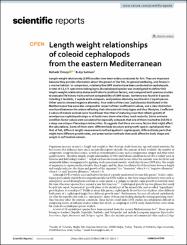Length weight relationships of coleoid cephalopods from the eastern Mediterranean
Citation
Önsoy B, Salman A. Length weight relationships of coleoid cephalopods from the eastern Mediterranean. Sci Rep. 2022 Jul 18;12(1):12256. doi: 10.1038/s41598-022-16611-7. PMID: 35851605; PMCID: PMC9293961.Abstract
Length-weight relationship (LWR) studies have been widely conducted for fish. They are important because they provide information about the growth of the fish, its general wellbeing, and fitness in a marine habitat. In comparison, relatively few LWR studies have been conducted on cephalopods. A total of 13,474 specimens belonging to 28 cephalopod species was investigated to define their length-weight relationship status and Fulton's condition factors, and compared with previous studies to evaluate life history traits and test comparability of LWR values. Isometry was found in 8 species including 2 teuthids, 2 sepiids and 4 octopods, and positive allometry was found in 2 squid species. Other species showed negative allometry. Four orders of the class Cephalopoda distributed in the Mediterranean Sea were also compared in respect of their coefficient b values, and a clear distinction was found between the orders reflecting their characteristic body types and thus lifestyles. Coefficient b values of mature animals were found lower than that of maturing ones that reflects growth of semelparous cephalopods stops or at least slows down when they reach maturity. Some extreme condition factor values were calculated for especially octopods that one of them reached to 140.91 in a deep-sea octopus Pteroctopus tetracirrhus. It suggests that there are many factors that might affect the calculations. Some of them were: different body structure and growth type in cephalopods than that of fish, different length measurement method applied in cephalopods, different body parts that might have different growth rates, and preservation methods that could affect the body shape and weight in soft bodied animals.


















